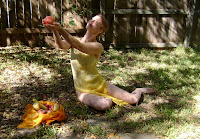 |
| Tunic on the Tracks in South Austin |
Duncan must have logged a lot of rail hours in her day—traveling by train across the United States, Europe, and Eurasia. Long-distance train travel is a less known phenomenon in contemporary U.S. culture, with the exception of the heavily trafficked northeast corridor from Washington, D.C. to Boston. Nevertheless, there are great benefits to travel by train (no traffic jams and fewer distracted drivers for starters).
A native of the Southeast United States, my first impressions of train tracks were twofold: you must lift your feet when you drive over them or risk losing your lover (an odd superstition to teach a young girl) and awareness that train tracks generally divided Southern towns along class and racial lines (hence the ominous phrase “the wrong side of the tracks”). I remember researching the price of train tickets from South Carolina to New York City, and feeling disappointed and disheartened to discover that Amtrack was just as pricey as Delta. Of course, I logged my fair share of rail hours when I eventually became a New Yorker—both subway, within the city, and commuter rails into Connecticut, upstate New York, and (my favorite trip) out to Long Beach, Long Island, for the glorious summertime beach pass.
While travel within Texas by passenger train is not yet a viable option, I am hopeful that some day hopping the train up to Dallas or down to San Antonio will be a convenience and a reality. In the meantime, there is the new METRORAIL commuter train from Leander to downtown Austin to explore, if you haven’t ridden it yet! Check out LightRailNow! if you’re interested in reading more about the call for light rail transport in Austin.
And, Austinites, if you’re hunkering for a ride on the rails, pronto, you’ve got options. The Austin Steam Train Association offers rides through the Hill Country on a train powered by an historic steam engine (check out the seasonal North Pole Flyer), and for those of you without several hours of local sightseeing time to spare, there’s always the Zilker Zephyr, Austin’s kid-friendly, twenty-minute circuit through the park, both departing and arrive at a depot conveniently across from Barton Springs.








